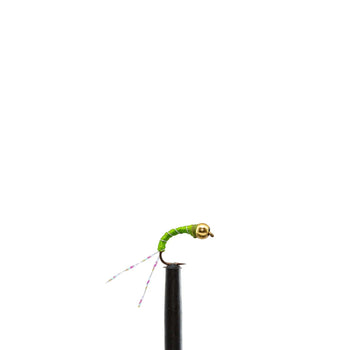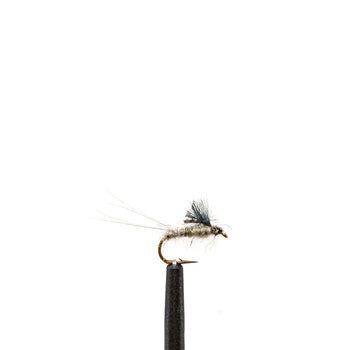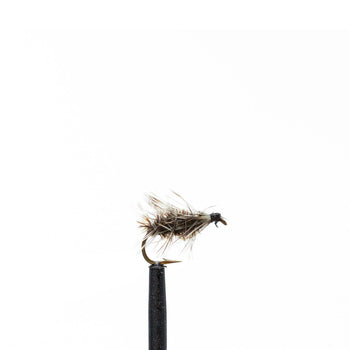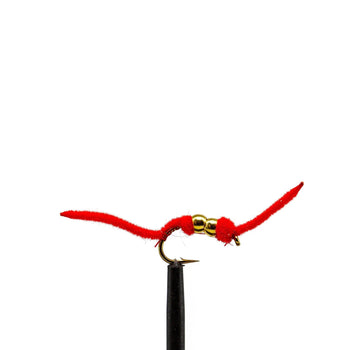The Marvelous Midge

Winter may bring freezing temperatures and snow-covered banks, but it's far from the end of fly fishing opportunities. In fact, for those willing to gear up and embrace the cold, winter offers some of the most peaceful and rewarding fishing experiences of the year. One of the keys to success during this time is understanding and utilizing midges—tiny insects that become a primary food source for trout when other options are scarce.
Midges are a fly angler's wintertime hero. Unlike caddisflies, mayflies, or stoneflies that dominate the warmer months, midges thrive in the cold. They hatch year-round, but their importance peaks during winter when they are often the only hatch occurring. For anglers willing to brave the cold, understanding and utilizing midge patterns can make the difference between a productive day on the water and a fishless one.
Why Midges Matter in Winter
Trout rely on midges for sustenance during winter because other aquatic insects are either dormant or less abundant. These tiny insects are available in larval, pupal, and adult stages, making them a versatile target for trout. Midges' small size and sheer numbers make them a reliable food source, even in the harshest conditions.
During snowy months, trout conserve energy by holding in slower-moving water, often near the bottom. This behavior aligns perfectly with the midge's life cycle, as midge larvae and pupae are commonly found drifting near the streambed. When midges hatch, the trout rise to sip the adults off the surface, creating excellent opportunities for dry fly fishing, even in January.
Understanding the midge lifecycle
The midge lifecycle has four life stages: egg, larvae, pupae, and adult. It is important to understand the three stages of larvae, pupae, and adult stages as it pertains to fly fishing. Once the midge egg is laid it will become dormant anywhere from a few days to a few months based on external conditions.

LARVAE – After the egg hatches, the midge becomes a larva. The larva looks like a tiny worm and is found in the substrate (bottom) of the river or lake. Midge larvae can be found in a variety of colors, most often black, red, or olive. Larvae are most active during the night, so if you do find yourself nymphing at night, larvae imitations can be effective.
Many of our beaded worm patterns are designed to resemble large clusters of midge larvae, mimicking their natural tendency to group together in the substrate. This clustered appearance can make these patterns especially enticing to trout feeding on concentrated food sources.
Suggested Fly Patterns for Larvae:
- Nickel Bead Black Zebra Midge
- Zebra Midge (various colors)
- Double Bead Ultra Worm (various colors)
Fishing Tips: Use these patterns as part of a nymph rig, fishing deep along the bottom. Adjust your depth to 1.5 times the water's depth for optimal results.
PUPAE – Once the midge larvae have reached maturity they begin to hatch into pupae. The pupae are much shorter and stockier than the larvae as the wings, legs, and gills have begun to form. The pupae are typically found just above the bottom (sub-surface) wiggling around trying to break free of their larvae sheath. Once the sheath is shed they begin their journey to the surface of the water. As this happens, a small air bubble is formed on the head of the midge. This can be imitated with flies by adding a flashy beadhead, flashback, or tuft to the fly.
Suggested Fly Patterns for Pupae:
- WD-40 (various colors)
- Chironomid Patterns
- Beadhead RS2
Fishing Tips: Fish these patterns below an indicator or on a slow drift to mimic rising pupae. Adding some flash to your fly can imitate the air bubble and attract trout.
ADULT – When midges become adults, they break the surface of the water and wriggle out of their pupal sheaths. The wings become visible, as the midge begins to shuck its pupal sheath. It will then sit on the surface of the water briefly as its wings dry out. Anglers can use tiny dry flies that imitate a single midge, or larger dry flies that imitate clusters of midges. Adult midges can live anywhere from a few days to a couple of weeks.
Suggested Fly Patterns for Adults:
- Griffith's Gnat
- Berger's Badger Gnat
- RS2 (as an emerger)
Fishing Tips: Target slack water, eddies, and surface-feeding trout. Cast upstream and allow your fly to drift naturally to mimic adult midges resting on the surface.
Techniques for Fishing Midges
When fishing midges, focus on their lifecycle rather than trying to identify the specific species. Determine the stage the midges are in—larva, pupa, or adult—and select flies accordingly. For example, during a larval hatch, use a two-fly nymph rig with a larva imitation paired with an attractor. Larvae typically drift deeper in the water column than pupae, so set your depth at about 1.5 times the water's depth for optimal results.
As you fish, observe the trout's behavior and adjust your rig based on their feeding patterns. If your pupa fly isn't getting strikes, try switching to a pair of larval imitations. When pupae start rising higher in the water column, move your indicator up to reflect this shift and consider imitating emerging midges. This transition often signals the start of a hatch, prompting trout to become more selective. Matching the hatch and fine-tuning your depth can significantly improve your success rate.

How to Fish Midges Effectively
1. Use Light Tippet: Midges are small, so thin tippet is essential. A thicker tippet can be too stiff for delicate midge flies, causing them to float unnaturally. Opt for 6x tippet to improve presentation.
2. Try Using Two Dries: To increase visibility, pair a larger midge pattern or one with a parachute feature with a smaller midge pattern tied 12-18 inches behind. This helps you track your flies and respond to rises effectively.
3. Look For Midges in the Water: Midge characteristics vary by water quality. For instance, low-oxygen streams often have bright red midge larvae, sometimes called bloodworms. Observing local water can guide you in selecting the right size and color.
4. Focus on Slack Water: Trout feeding on adult midges often cruise slack water around rocks and banks. These areas are challenging because your fly can blend in with the natural midges. Consider using a slightly larger fly or adding subtle flash to help your fly stand out.
5. Use a Smaller Indicator: Since midges are lightweight, a subtle strike indicator is crucial to detect soft takes. Winter months are the time to stash larger indicators in favor of something more discreet.
6. Focus on All Stages: Include patterns that imitate larval, pupal, and adult stages. Subsurface options like Zebra Midges and WD-40s are reliable, while Griffith's Gnats and midge clusters excel on the surface.
7. Adjust Your Presentation: Trout in cold water are less likely to chase flies. Mimic the natural movement of midges by using slow drifts and dead-drifting techniques.
8. Timing is Key: Midge activity peaks during the warmest part of the day, often midday. Plan your outings accordingly to align with these hatches.
Top 10 Midge Patterns for Success
Midges are among the most reliable food sources for trout, making them a cornerstone of any angler's fly box. From larval imitations to dry flies that mimic adults, these patterns offer versatility and effectiveness across various conditions. Here are the top 10 midge patterns that every angler should carry:
 |
 |
 |
 |
 |
| Nickel Bead Black Zebra Midge | Zebra Midge | WD-40 | RS2 | Beadhead RS2 |
 |
 |
 |
 |
 |
| Griffith's Gnat | Disco Midge | Lazer Midge | Brassy | Double Bead Ultra Worms |
1. Nickel Bead Black Zebra Midge: A classic larval and pupal imitation. This fly's slim profile and bead head allow it to drift naturally in cold, clear waters. Best fished deep under an indicator or as the bottom fly in a double rig.
2. Zebra Midge (various colors): A versatile fly available in multiple colors, including red and olive. It imitates both larval and pupal stages effectively. Ideal for deep, slow drifts in tailwaters or when trout are feeding near the bottom.
3. WD-40 (various colors): A simple yet effective midge pupae imitation. Best fished subsurface during hatches when trout are keyed in on emerging insects. This fly's subtle design excels in clear, pressured waters.
4. RS2: This fly mimics emerging midges and other small aquatic insects. Fish it on the swing or dead drift in slower water. Its subtle sparkle attracts trout feeding on emergers.
5. Beadhead RS2: A weighted variation of the RS2 that sinks quickly to target trout feeding on emerging insects. Best fished subsurface in deeper runs or slow-moving pools.
6. Griffith's Gnat: An iconic dry fly for imitating adult midges or clusters of midges. Use it on the surface in slack water or eddies where trout sip adults. The Griffith's Gnat is especially useful in winter conditions.
7. Disco Midge (various colors): A flashy larval pattern with bright colors to attract trout in both clear and murky waters. Fish it subsurface to mimic drifting larvae in tailwaters or freestone streams.
8. Lazer Midge (various colors): This highly visible midge pattern incorporates reflective materials to mimic natural pupae rising to the surface. Best fished just below the water's surface.
9. Brassy (various colors): A timeless midge larval pattern with a segmented wire body. It's particularly effective in bright conditions or heavily fished waters. Fish it deep near the substrate.
10. Double Bead Ultra Worms (various colors): A highly effective larval pattern designed to resemble large clusters of midge larvae. The two beads add weight for deep presentations, making it ideal for nymph rigs in slow-moving or deep water. Best fished close to the bottom where trout are feeding on concentrated food sources.
These patterns cover various stages of the midge life cycle and work well in different conditions. Having these in your fly box ensures you're prepared to match the hatch and entice even the pickiest trout.
The Year-Round Versatility of Midges
While midges shine in winter, they are an essential part of a trout's diet year-round. Their constant presence makes them a reliable choice, whether you're fishing during the first thaw of spring, the heat of summer, or the crisp days of fall. Learning to fish midges effectively will serve you well in any season.
Embrace Winter Fly Fishing
Winter fly fishing requires patience, preparation, and a willingness to adapt. But it also rewards those who venture out with solitude, stunning scenery, and the satisfaction of hooking trout when others stay indoors. Midges, with their year-round availability and winter prominence, are the perfect fly to help you unlock this season's potential.
Bundle up, tie on a trusty midge pattern, and hit the water this winter. Whether you're fishing a tailwater, spring creek, or freestone stream, you'll find that these marvelous insects can turn even the coldest days into memorable fishing adventures.
SHOP OUR MIDGE LIFE STAGES COLLECTION
RELATED ARTICLES:
- The Ultimate Winter Fly Fishing Guide: Seven Tips & Flies for Success
- Diving Deep: The Ultimate Guide to Tungsten Bead Fly Patterns
- The Captivating Midge Cluster
- 20 Essential Winter Fly Patterns
- Cold Water Conquests: Navigating the Challenges of Winter Fly Fishing
- Essential Fly Fishing Knots: 10 Key Ties for Angling Success







